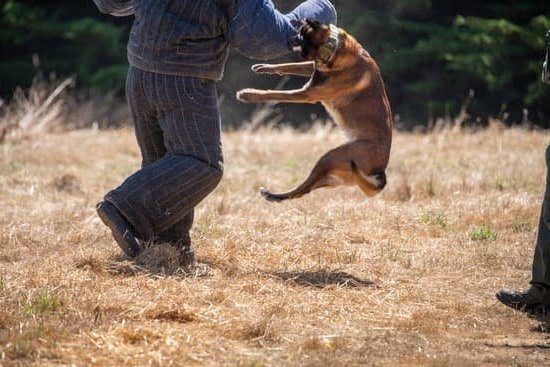Introduction
Sheep dog training is a special type of skill that involves teaching your furry companion how to help out on the farm. Sheep dogs are essential for rounding up and managing flocks, so having well-trained dogs is essential on any kind of sheep-raising operation. Training them to herd sheep requires practice, patience, and dedication from both the trainer and their pup.
Through sheep dog training, you can teach your puppy the proper herding commands such as walking ahead of the flock, circling around them, lying down flat in front of them to block their path, pushing them back if they stray too far away or preventing stragglers from getting separated from the rest of the pack. Each command must be repeated several times until it becomes an instinctive behavior in your four-legged student. Additionally, as part of their training they will also learn how not to chase after prey or other animals while herding the flock. They should also learn how to respond to more general commands such as “come” or “sit” regardless of their environment. This can help make sure that your dog does not become distracted when managing a large flock. Finally, it is important for handlers to take time to play with the animal during breaks so that shepherding does not become a chore for either one involved. With enough time and effort invested into training your pup, she will become an invaluable asset on any sheep-raising operation.
What Is Sheep Dog Training?
Sheep dog training is the practice of teaching dogs to herd and control sheep. It requires patience, strong communication skills, coordination, and an understanding of animal behavior. Training takes place in a variety of environments and is used to accomplish various tasks such as keeping flock sizes under control or dispersing pests. The goal of this type of training is for the handler and the dog to work in tandem when it comes to controlling and directing the flock. During the process, handler-dog teams will learn a variety of commands and cues that are used to guide the animals in their desired direction. Additionally, shepherds train their dogs to respond quickly to any changes in the environment or with behaviours exhibited by their animals. Ultimately sheep dog training teaches handlers how best to manage their flocks and keeps them safe in times of need.
The Benefits of Sheep Dog Training
Sheep dog training is a rewarding activity for both the dog and the shepherd. It develops a strong bond between the two and provides an efficient way to herd sheep and other livestock. Training involves teaching basic commands, as well as more complex behaviors such as directing sheep into various pens.
The benefits of teaching your sheepdog how to properly herd livestock are numerous. For one, it eliminates the need for you to manually herd the animals, reducing potential for injury, stress, or exhaustion on your part. It also ensures that sheep stay in designated areas and helps keep order in the flock. Additionally, a trained dog is easier to control and can be used in any environment with confidence. By teaching your sheepdog commands and behaviors, you can ensure that your flock remains safe in any situation.
Moreover, many shepherds find that they gain an emotional benefit from training their dogs, with an increased sense of companionship and understanding between them and their dogs. Sheepdogs who receive consistent training often become calmer around people and other animals involved in herding operations. This makes them better companions on farms or at demonstrations of herding techniques elsewhere in the world. Additionally, these specially trained dogs are often used in search-and-rescue missions because they have excellent tracking abilities that make mapping out terrain much simpler than if done by humans alone.
Preparing Your Sheep Dog for Training
Sheep dog training is a lengthy journey of building understanding, trust and respect between your canine and the sheep. The first step in this process is preparing your pup. It is important to start young with pups that are 8-weeks or older. If you are using an adult dog, they should still have a positive attitude towards learning new things. The next step is finding a place that allows you to practice the skills required during sheep herding such as having an adequate space and access to movable panels or gates that can be used to create enclosures for the animals. The most important part of preparing your pup for training is building positive reinforcement techniques through frequent use of treats and verbal praise. This helps build his confidence when it comes to problem solving, as well as establishes obedience around livestock before beginning any experiencedbased activities with the sheep. Finally, regular exposure to unfamiliar livestock will help ensure your pup becomes familiar with their unique behaviors – making it easier for him to respond appropriately when confronted with them.
Essential Sheep Dog Training Techniques
Sheep dog training typically begins with basic commands such as “come”, “stop” and “sit”. It is important to use positive reinforcement when teaching these commands. Typically you should reward the sheepdog after it has done something correctly with a treat or verbal praise. A sheepdog needs consistent repetition of these commands so they are consistently followed.
Once the basic commands are understood, the owner can progress onto developing the specific skills necessary for effective herding behaviour. This includes teaching the shepherd which types of whistle signals will cue different types of behaviours from potential reactions to running and other herd movements, as well as calling back commands and specific instructions to the flock itself. Additionally, physical handling must be taught for rounding up larger flocks or keeping them in line during transport. Eye contact is another key aspect of sheepdog training that must be taught consistently- reinforcing through simple rewards like treats or verbal praise whenever eye contact is maintained on command helps ensure that your sheepdog learns to keep appropriate focus during herding activities. Finally, learning to manoeuvre yourself can also become part of your dog’s work by knowing how far away you want them to stay or when to close gaps between themselves and their flock during herding activity.
Understanding the Basics of Sheep Dog Training
Sheep dog training is a rewarding process that involves teaching a dog how to manage and herd sheep efficiently. It requires patience and dedication, as well as plenty of positive reinforcement. The basics of sheep dog training involve building trust between the owner and the dog, teaching commands such as come, sit, stay and stop, as well as whistle commands which help the handler guide the direction of their animal. As the dog gets more experienced with understanding basic commands, their role progresses to their ability to learn advanced techniques such as flankings (changing position from one side of the flock to the other), penalties (correcting the path of a misbehaving animal) and fetching (retrieving and guiding lost sheep back into formation). The end goal for many owners is for their animals to qualify for competitions in which they can show off both their hard work and skill level when managing livestock in fields or even within an arena setting. With good care, training and commitment from both parties involved in this process, owners will have developed a healthy bond with a capable herding partner while gaining the satisfaction of helping raise high quality animals.
Common Mistakes in Sheep Dog Training
One of the most common mistakes when it comes to training sheep dogs is not providing enough incentive for the dog to work. Proper incentives such as a tasty food reward or a toy will go a long way towards teaching the necessary skills and getting desired behaviors. Often, inexperienced handlers will try to use commands only without offering any kind of reward – however, this is generally ineffective as it fails to address the underlying motivators ensuring proper behavior.
Another mistake made by inexperienced handlers is that they often fail to get their dog’s full attention before giving command. Dogs learn best when they are completely focused on their owners so it’s important that owners take the time to ensure that their dog’s attention is totally with them before any form of instruction is given.
In addition, many trainers don’t properly reinforce good behaviors sufficiently nor do they correct bad behaviors quickly enough which can lead to confusion for the animal about expected standards and rules of engagement, effectively stifling growth in training progress. It’s important that both positive and negative feedback be given quickly in order to provide an accurate behavioral indicator for success or failure in activities.
Choosing the Right Type of Dog for Sheep Dog Training
People who are interested in sheep dog training must begin with choosing the right type of dog for the job. Many fail to recognize how different breeds of dogs are suited for different types of herding, or that a large variety of breeds can make excellent working border collies, such as vizslas, german shepherds, australian cattle dogs, and more. It is important to recognize your own skills as a trainer and pair that with the qualities each type of dog brings to the table when looking at candidates for sheepdog training.
Not only should one consider temperament when selecting which type of dog to train for sheepdog work, but also physical characteristics such as agility, speed and size. For instance, heavy-bodied dogs with thick coats (like some Mediterranean breeds) may not be suitable for damp environments; while smaller and lighter-bodied dogs may struggle with controlling larger flocks. When considering breeds it is important to keep in mind individual needs like those mentioned above – and even more significantly the flock’s needs – in order to choose the most appropriate breed or blend of breeds from which to select your working canine partner.
Furthermore, experience should be taken into account when deciding upon a breed or breed-mix ideal for your purpose. Those who have worked with a certain breed of herding dog previously will be better equipped to judge whether that particular breed suits their capabilities or circumstances. Additionally, talking to local farmers highly experienced with herding can provide valuable insight in terms of which breeds are best suited for specific geographic regions or climates where you might expect differences in vegetation and other environmental challenges. Ultimately deciding what works best for you is a balancing act between your knowledge and experience, physical requirements of the terrain/climate you’ll be working in -and ultimately what works best for the flock!
Essential Tools and Equipment for Sheep Dog Training
One of the most critical elements of sheep dog training is having the right tools and equipment. Before you embark on any training program, you should ensure that you have the right supplies to make it a successful experience. Here are some of the essential tools and pieces of equipment you’ll need:
-A collar and leash: This provides you with control over your dog at all times while they’re learning commands. Make sure to buy a comfortable, adjustable collar for your dog, as well as a sturdy but lightweight leash that won’t drag on their neck or body during the training session.
-A long crop: A long crop is an important tool used in sheep herding to help direct the flock in different directions without having to touch them directly. It is also great for giving rewards as it allows you to give gentle taps and flicks without having to touch your pup or produce unpleasant loud noises.
-Treat pouch: A treat pouch allows you to effectively reward your puppy or adult dog quickly when they complete commands correctly during training. Furthermore, treat pouches avoid distractions by keeping treats contained and ready in one place.
-Whistle: Whistles are very useful for teaching basic commands such as sit, stay and come back from longer distances. They can prove invaluable if your pup doesn’t respond promptly to verbal cues.
-A boundary line flagging tape: Flagging tape helps mark boundaries which can be key if your pup has trouble understanding where they are allowed or not allowed to go during herding activities. Not only does this help keep them safe, but it also helps them understand where their limits lie during different forms of exercise and playtime.
Troubleshooting Problem Behaviors in Sheep Dog Training
One of the common issues that arise in the process of sheep dog training is the development of problem behaviors. These can range from dogs not responding to commands, to barking or nipping at the sheep, to becoming too aggressive with them. It’s important for any shepherd to recognize these potential problems and troubleshoot them as soon as possible so that all parties involved are safe and happy.
In order to fix problem behavior in a sheep dog it is necessary for the shepherd to first understand what is causing this behavior. Generally, problem behavior occurs due to a lack of training or an incorrect method used during the training session. It could also come from inadequate socialization or insufficient corrections when mistakes are made.
Once the cause of the unwanted behavior has been identified, it is then time to start working on some solutions. Puppies and young dogs often respond best to repetitive drills involving positive reinforcement while older, more experienced dogs may need more complex drills and stringent correction if they do not comply with commands. Correcting mistimed executions of tasks should be done quickly but calmly; scolding a dog too harshly can lead to more undesirable behaviors than appropriate ones!
Socialization must also play an integral part in fixing problem behaviors in sheepdog training. This means introducing new people, animals, and environment regularly so that your pup becomes comfortable in their surroundings and learns how best to interact with them accordingly! Playing interactive games such as tug-of-war or hide-and-seek helps reinforce good behaviors while teaching rules such as “off” and “stay”. Finally, make sure that you reward your pup for good actions – this encourages your pup even further!
Conclusion
Investing in sheep dog training can be an invaluable decision for both experienced and inexperienced shepherds alike. After carefully laying out a good foundation for the training of their sheepdog, implementation of these lessons will result in effective communication between shepherd and dog. This communication can then help any shepherd better manage their flock, enhance safety protocols, and make the everyday life of a shepherd much easier. Additionally, investing in professional training may also improve the overall value of their sheepdog since well-trained animals are better able to market themselves as service animals. Not only will they be of use to their current shepherds, but they could also make a valuable addition to any future shepherds’ flock. All in all, investing into the sheep dog training process is often rewarding both financially and emotionally for all parties involved.

Welcome to the blog! I am a professional dog trainer and have been working with dogs for many years. In this blog, I will be discussing various topics related to dog training, including tips, tricks, and advice. I hope you find this information helpful and informative. Thanks for reading!





